window FIAT IDEA 2007 1.G Owner's Guide
[x] Cancel search | Manufacturer: FIAT, Model Year: 2007, Model line: IDEA, Model: FIAT IDEA 2007 1.GPages: 314, PDF Size: 4.78 MB
Page 175 of 314
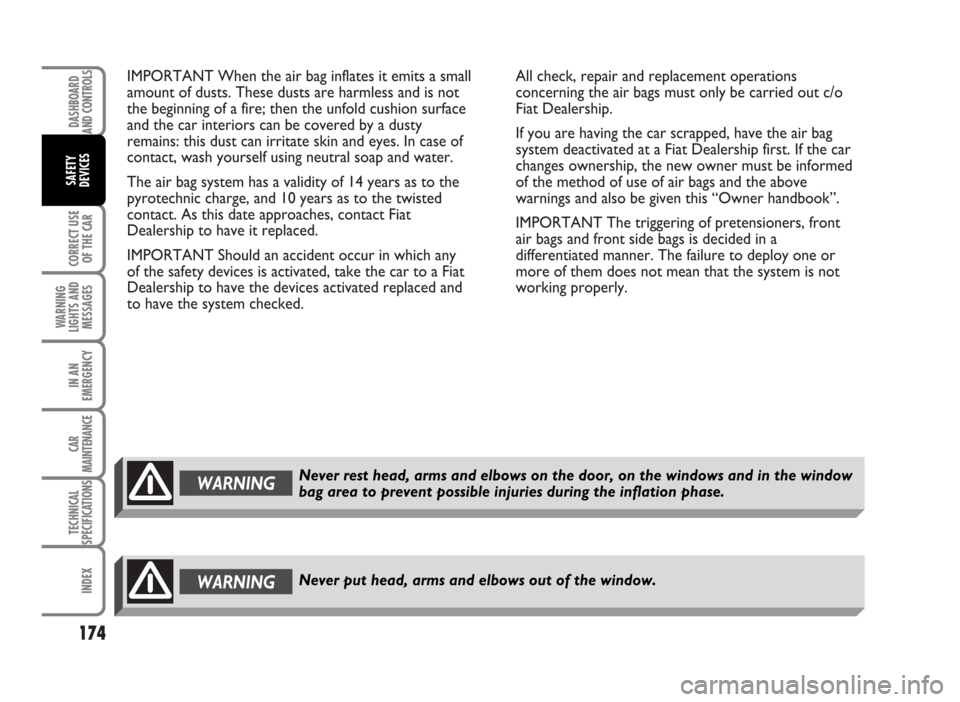
IMPORTANT When the air bag inflates it emits a small
amount of dusts. These dusts are harmless and is not
the beginning of a fire; then the unfold cushion surface
and the car interiors can be covered by a dusty
remains: this dust can irritate skin and eyes. In case of
contact, wash yourself using neutral soap and water.
The air bag system has a validity of 14 years as to the
pyrotechnic charge, and 10 years as to the twisted
contact. As this date approaches, contact Fiat
Dealership to have it replaced.
IMPORTANT Should an accident occur in which any
of the safety devices is activated, take the car to a Fiat
Dealership to have the devices activated replaced and
to have the system checked.All check, repair and replacement operations
concerning the air bags must only be carried out c/o
Fiat Dealership.
If you are having the car scrapped, have the air bag
system deactivated at a Fiat Dealership first. If the car
changes ownership, the new owner must be informed
of the method of use of air bags and the above
warnings and also be given this “Owner handbook”.
IMPORTANT The triggering of pretensioners, front
air bags and front side bags is decided in a
differentiated manner. The failure to deploy one or
more of them does not mean that the system is not
working properly.
174
CORRECT USE
OF THE CAR
WARNING
LIGHTS AND
MESSAGES
IN AN
EMERGENCY
CAR
MAINTENANCE
TECHNICAL
SPECIFICATIONS
INDEX
DASHBOARD
AND CONTROLS
SAFETY
DEVICES
WARNINGNever rest head, arms and elbows on the door, on the windows and in the window
bag area to prevent possible injuries during the inflation phase.
WARNINGNever put head, arms and elbows out of the window.
Page 184 of 314
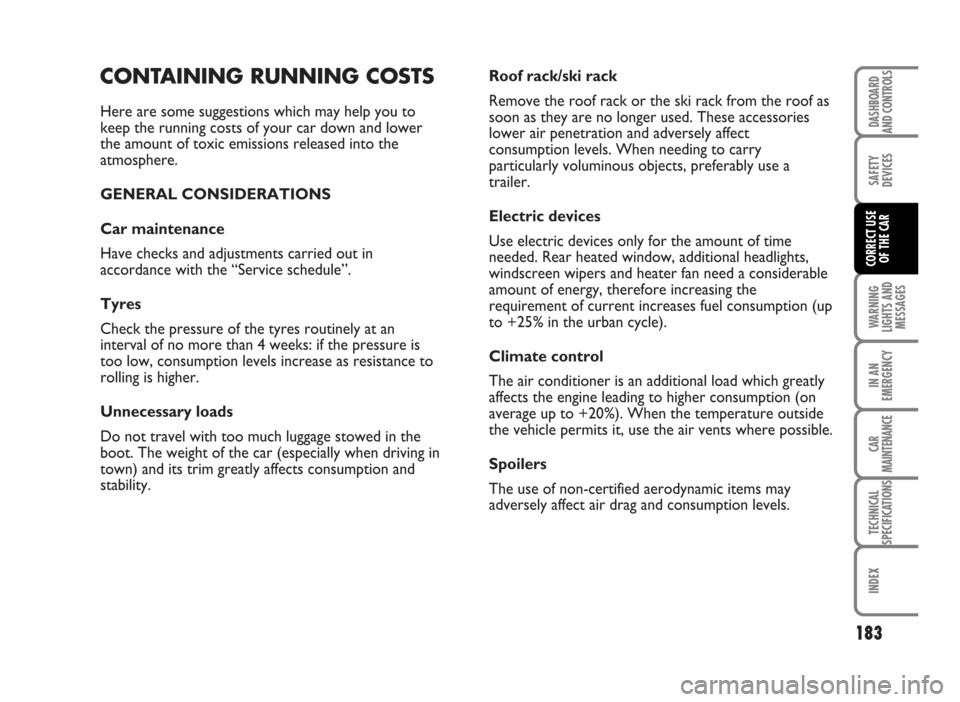
CONTAINING RUNNING COSTS
Here are some suggestions which may help you to
keep the running costs of your car down and lower
the amount of toxic emissions released into the
atmosphere.
GENERAL CONSIDERATIONS
Car maintenance
Have checks and adjustments carried out in
accordance with the “Service schedule”.
Tyres
Check the pressure of the tyres routinely at an
interval of no more than 4 weeks: if the pressure is
too low, consumption levels increase as resistance to
rolling is higher.
Unnecessary loads
Do not travel with too much luggage stowed in the
boot. The weight of the car (especially when driving in
town) and its trim greatly affects consumption and
stability.Roof rack/ski rack
Remove the roof rack or the ski rack from the roof as
soon as they are no longer used. These accessories
lower air penetration and adversely affect
consumption levels. When needing to carry
particularly voluminous objects, preferably use a
trailer.
Electric devices
Use electric devices only for the amount of time
needed. Rear heated window, additional headlights,
windscreen wipers and heater fan need a considerable
amount of energy, therefore increasing the
requirement of current increases fuel consumption (up
to +25% in the urban cycle).
Climate control
The air conditioner is an additional load which greatly
affects the engine leading to higher consumption (on
average up to +20%). When the temperature outside
the vehicle permits it, use the air vents where possible.
Spoilers
The use of non-certified aerodynamic items may
adversely affect air drag and consumption levels.
183
SAFETY
DEVICES
WARNING
LIGHTS AND
MESSAGES
IN AN
EMERGENCY
CAR
MAINTENANCE
TECHNICAL
SPECIFICATIONS
INDEX
DASHBOARD
AND CONTROLS
CORRECT USE
OF THE CAR
Page 191 of 314
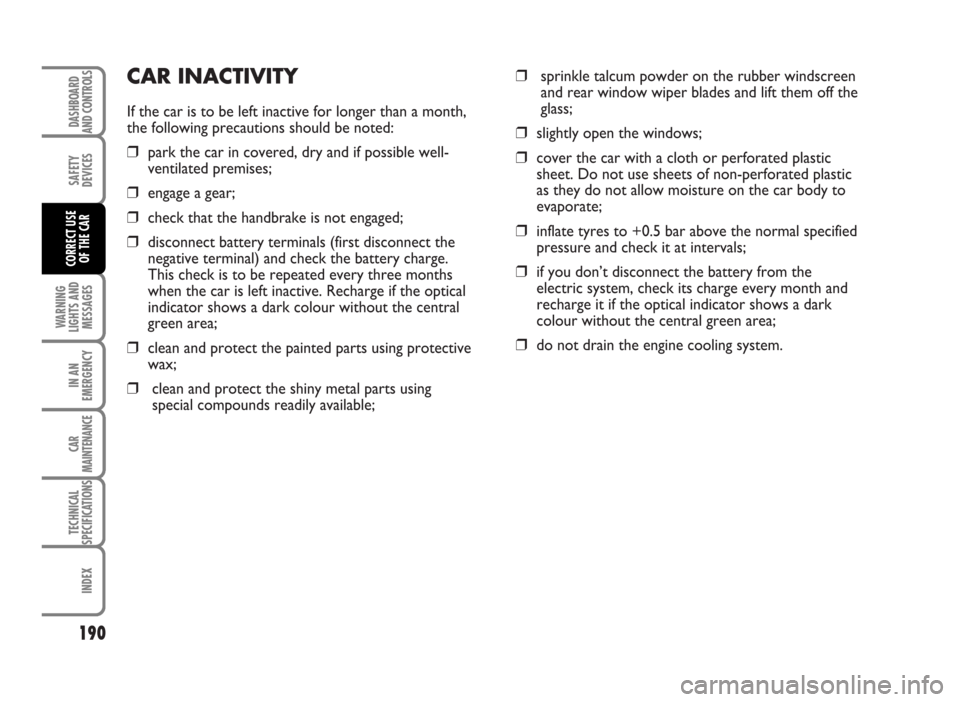
CAR INACTIVITY
If the car is to be left inactive for longer than a month,
the following precautions should be noted:
❒park the car in covered, dry and if possible well-
ventilated premises;
❒engage a gear;
❒check that the handbrake is not engaged;
❒disconnect battery terminals (first disconnect the
negative terminal) and check the battery charge.
This check is to be repeated every three months
when the car is left inactive. Recharge if the optical
indicator shows a dark colour without the central
green area;
❒clean and protect the painted parts using protective
wax;
❒clean and protect the shiny metal parts using
special compounds readily available;❒sprinkle talcum powder on the rubber windscreen
and rear window wiper blades and lift them off the
glass;
❒slightly open the windows;
❒cover the car with a cloth or perforated plastic
sheet. Do not use sheets of non-perforated plastic
as they do not allow moisture on the car body to
evaporate;
❒inflate tyres to +0.5 bar above the normal specified
pressure and check it at intervals;
❒if you don’t disconnect the battery from the
electric system, check its charge every month and
recharge it if the optical indicator shows a dark
colour without the central green area;
❒do not drain the engine cooling system.
190
SAFETY
DEVICES
WARNING
LIGHTS AND
MESSAGES
IN AN
EMERGENCY
CAR
MAINTENANCE
TECHNICAL
SPECIFICATIONS
INDEX
DASHBOARD
AND CONTROLS
CORRECT USE
OF THE CAR
Page 246 of 314
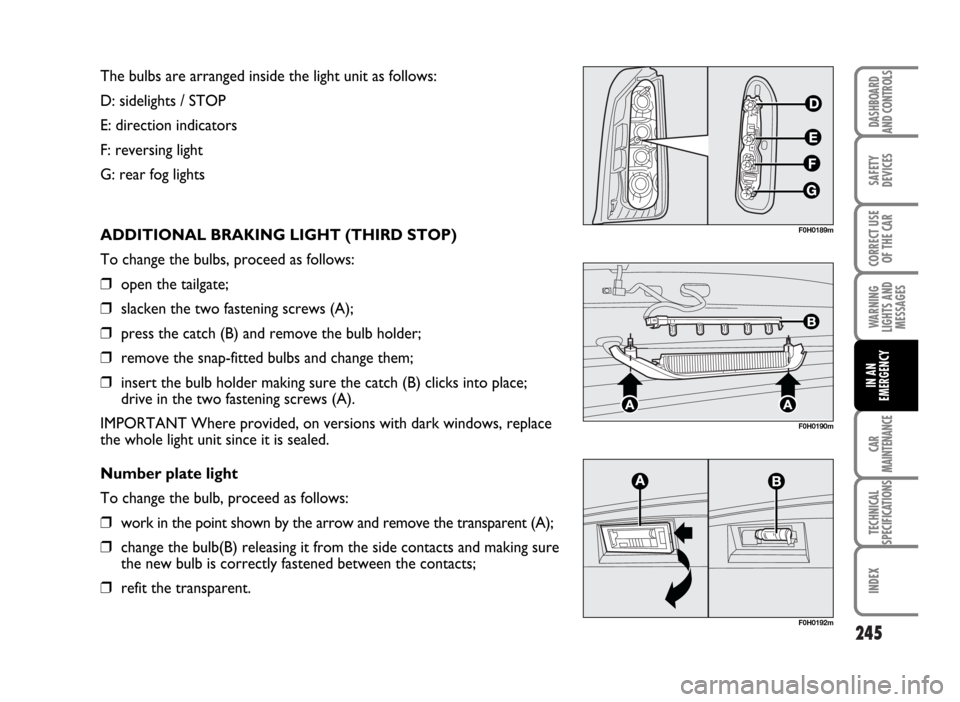
245
SAFETY
DEVICES
CORRECT USE
OF THE CAR
WARNING
LIGHTS AND
MESSAGES
CAR
MAINTENANCE
TECHNICAL
SPECIFICATIONS
INDEX
DASHBOARD
AND CONTROLS
IN AN
EMERGENCY
The bulbs are arranged inside the light unit as follows:
D: sidelights / STOP
E: direction indicators
F: reversing light
G: rear fog lights
ADDITIONAL BRAKING LIGHT (THIRD STOP)
To change the bulbs, proceed as follows:
❒open the tailgate;
❒slacken the two fastening screws (A);
❒press the catch (B) and remove the bulb holder;
❒remove the snap-fitted bulbs and change them;
❒insert the bulb holder making sure the catch (B) clicks into place;
drive in the two fastening screws (A).
IMPORTANT Where provided, on versions with dark windows, replace
the whole light unit since it is sealed.
Number plate light
To change the bulb, proceed as follows:
❒work in the point shown by the arrow and remove the transparent (A);
❒change the bulb(B) releasing it from the side contacts and making sure
the new bulb is correctly fastened between the contacts;
❒refit the transparent.
F0H0190m
F0H0192m
F0H0189m
Page 252 of 314
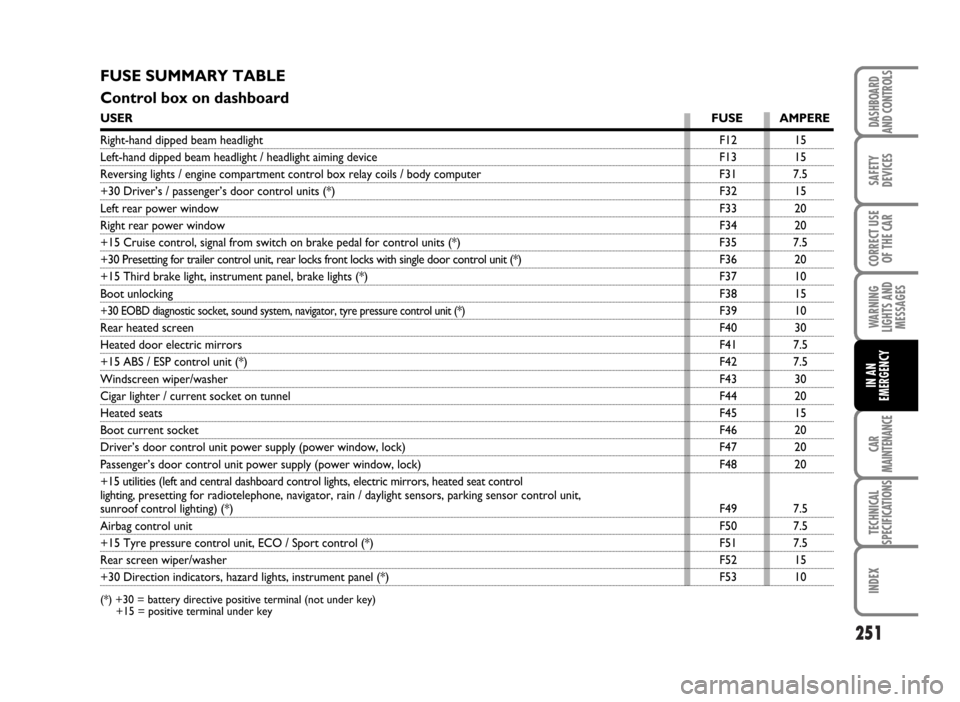
251
SAFETY
DEVICES
CORRECT USE
OF THE CAR
WARNING
LIGHTS AND
MESSAGES
CAR
MAINTENANCE
TECHNICAL
SPECIFICATIONS
INDEX
DASHBOARD
AND CONTROLS
IN AN
EMERGENCY
FUSE SUMMARY TABLE
Control box on dashboard
USERFUSE AMPERE
Right-hand dipped beam headlightF12 15
Left-hand dipped beam headlight / headlight aiming device F13 15
Reversing lights / engine compartment control box relay coils / body computer F31 7.5
+30 Driver’s / passenger’s door control units (*)F32 15
Left rear power windowF33 20
Right rear power windowF34 20
+15 Cruise control, signal from switch on brake pedal for control units (*) F35 7.5
+30 Presetting for trailer control unit, rear locks front locks with single door control unit (*) F36 20
+15 Third brake light, instrument panel, brake lights (*) F37 10
Boot unlockingF38 15
+30 EOBD diagnostic socket, sound system, navigator, tyre pressure control unit (*)F39 10
Rear heated screenF40 30
Heated door electric mirrorsF41 7.5
+15 ABS / ESP control unit (*)F42 7.5
Windscreen wiper/washerF43 30
Cigar lighter / current socket on tunnelF44 20
Heated seatsF45 15
Boot current socketF46 20
Driver’s door control unit power supply (power window, lock) F47 20
Passenger’s door control unit power supply (power window, lock) F48 20
+15 utilities (left and central dashboard control lights, electric mirrors, heated seat control
lighting,presetting for radiotelephone, navigator, rain / daylight sensors, parking sensor control unit,
sunroof control lighting) (*)F49 7.5
Airbag control unitF50 7.5
+15 Tyre pressure control unit, ECO / Sport control (*) F51 7.5
Rear screen wiper/washerF52 15
+30 Direction indicators, hazard lights, instrument panel (*) F53 10
(*) +30 = battery directive positive terminal (not under key)
+15 = positive terminal under key
Page 259 of 314
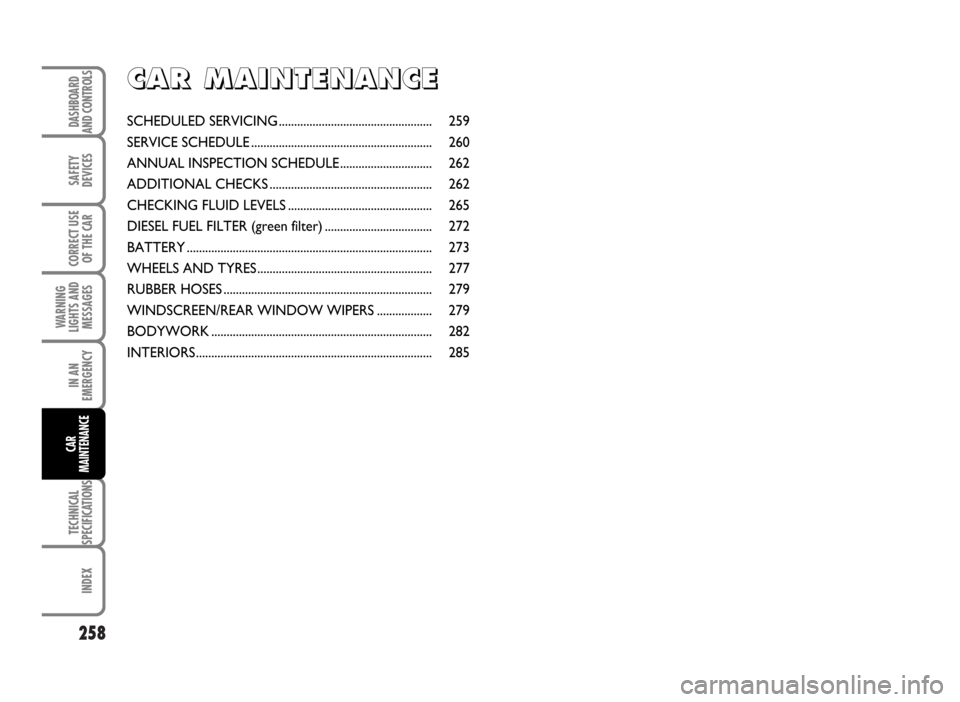
258
SAFETY
DEVICES
CORRECT USE
OF THE CAR
WARNING
LIGHTS AND
MESSAGES
IN AN
EMERGENCY
TECHNICAL
SPECIFICATIONS
INDEX
DASHBOARD
AND CONTROLS
CAR
MAINTENANCE
C C
A A
R R
M M
A A
I I
N N
T T
E E
N N
A A
N N
C C
E E
SCHEDULED SERVICING .................................................. 259
SERVICE SCHEDULE ........................................................... 260
ANNUAL INSPECTION SCHEDULE .............................. 262
ADDITIONAL CHECKS ..................................................... 262
CHECKING FLUID LEVELS ............................................... 265
DIESEL FUEL FILTER (green filter) ................................... 272
BATTERY ................................................................................ 273
WHEELS AND TYRES ......................................................... 277
RUBBER HOSES .................................................................... 279
WINDSCREEN/REAR WINDOW WIPERS .................. 279
BODYWORK ........................................................................ 282
INTERIORS............................................................................. 285
Page 266 of 314
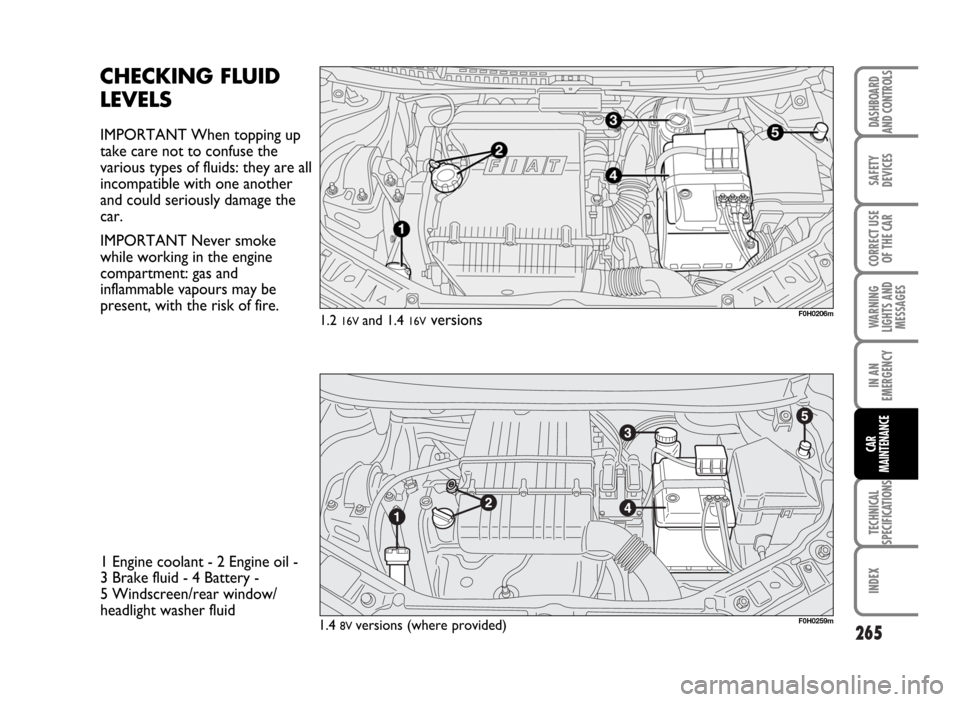
265
SAFETY
DEVICES
CORRECT USE
OF THE CAR
WARNING
LIGHTS AND
MESSAGES
IN AN
EMERGENCY
TECHNICAL
SPECIFICATIONS
INDEX
DASHBOARD
AND CONTROLS
CAR
MAINTENANCE
CHECKING FLUID
LEVELS
IMPORTANT When topping up
take care not to confuse the
various types of fluids: they are all
incompatible with one another
and could seriously damage the
car.
IMPORTANT Never smoke
while working in the engine
compartment: gas and
inflammable vapours may be
present, with the risk of fire.
1 Engine coolant - 2 Engine oil -
3 Brake fluid - 4 Battery -
5 Windscreen/rear window/
headlight washer fluid
F0H0206m1.2 16V and 1.4 16Vversions
F0H0259m1.4 8V versions (where provided)
Page 267 of 314
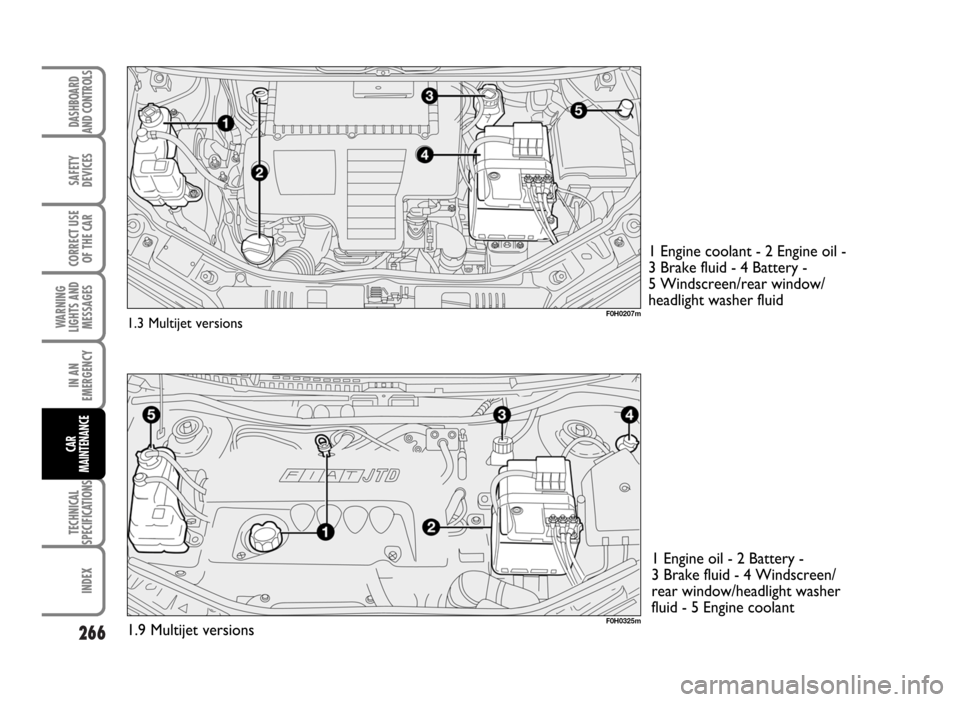
266
SAFETY
DEVICES
CORRECT USE
OF THE CAR
WARNING
LIGHTS AND
MESSAGES
IN AN
EMERGENCY
TECHNICAL
SPECIFICATIONS
INDEX
DASHBOARD
AND CONTROLS
CAR
MAINTENANCE
1 Engine oil - 2 Battery -
3 Brake fluid - 4 Windscreen/
rear window/headlight washer
fluid - 5 Engine coolant
F0H0325m1.9 Multijet versions
F0H0207m1.3 Multijet versions
1 Engine coolant - 2 Engine oil -
3 Brake fluid - 4 Battery -
5 Windscreen/rear window/
headlight washer fluid
Page 271 of 314
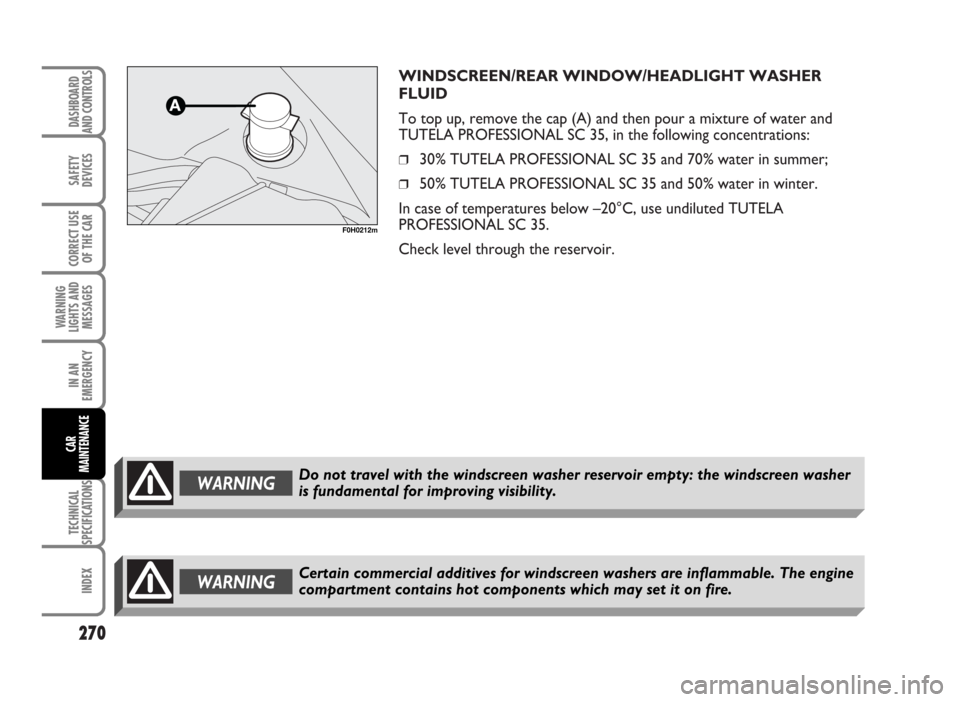
WINDSCREEN/REAR WINDOW/HEADLIGHT WASHER
FLUID
To top up, remove the cap (A) and then pour a mixture of water and
TUTELA PROFESSIONAL SC 35, in the following concentrations:
❒30% TUTELA PROFESSIONAL SC 35 and 70% water in summer;
❒50% TUTELA PROFESSIONAL SC 35 and 50% water in winter.
In case of temperatures below –20°C, use undiluted TUTELA
PROFESSIONAL SC 35.
Check level through the reservoir.
270
SAFETY
DEVICES
CORRECT USE
OF THE CAR
WARNING
LIGHTS AND
MESSAGES
IN AN
EMERGENCY
TECHNICAL
SPECIFICATIONS
INDEX
DASHBOARD
AND CONTROLS
CAR
MAINTENANCE
F0H0212m
WARNINGDo not travel with the windscreen washer reservoir empty: the windscreen washer
is fundamental for improving visibility.
WARNINGCertain commercial additives for windscreen washers are inflammable. The engine
compartment contains hot components which may set it on fire.
Page 280 of 314
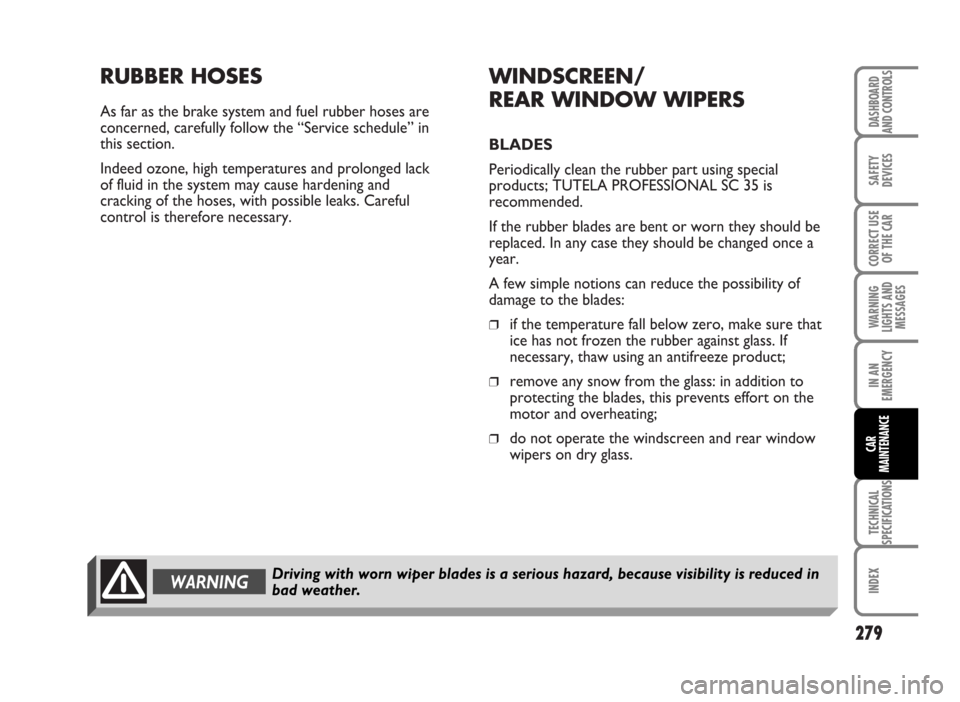
RUBBER HOSES
As far as the brake system and fuel rubber hoses are
concerned, carefully follow the “Service schedule” in
this section.
Indeed ozone, high temperatures and prolonged lack
of fluid in the system may cause hardening and
cracking of the hoses, with possible leaks. Careful
control is therefore necessary.
WINDSCREEN/
REAR WINDOW WIPERS
BLADES
Periodically clean the rubber part using special
products; TUTELA PROFESSIONAL SC 35 is
recommended.
If the rubber blades are bent or worn they should be
replaced. In any case they should be changed once a
year.
A few simple notions can reduce the possibility of
damage to the blades:
❒if the temperature fall below zero, make sure that
ice has not frozen the rubber against glass. If
necessary, thaw using an antifreeze product;
❒remove any snow from the glass: in addition to
protecting the blades, this prevents effort on the
motor and overheating;
❒do not operate the windscreen and rear window
wipers on dry glass.
279
SAFETY
DEVICES
CORRECT USE
OF THE CAR
WARNING
LIGHTS AND
MESSAGES
IN AN
EMERGENCY
TECHNICAL
SPECIFICATIONS
INDEX
DASHBOARD
AND CONTROLS
CAR
MAINTENANCE
WARNINGDriving with worn wiper blades is a serious hazard, because visibility is reduced in
bad weather.